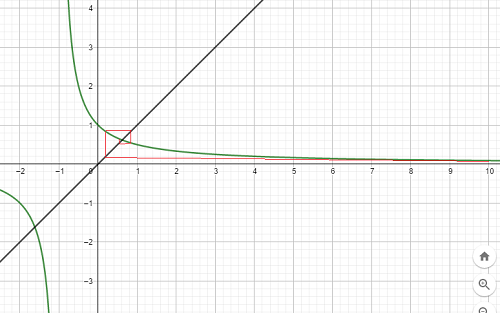Flipping Fractions
If t 0 = 1 0 and t n = 1 + t n − 1 1 , then n → ∞ lim t n = c a − b , where a , b , and c are co-prime positive integers.
Find a + b + c .
The answer is 8.
This section requires Javascript.
You are seeing this because something didn't load right. We suggest you, (a) try
refreshing the page, (b) enabling javascript if it is disabled on your browser and,
finally, (c)
loading the
non-javascript version of this page
. We're sorry about the hassle.
4 solutions
Simple and elegant! Thanks for posting.
t 1 t 2 t 3 ⋯ = 1 + t 0 1 = 1 + t 1 1 = 1 + 1 + t 0 1 1 = 1 + 1 + 1 + t 0 1 1 1 = ⋯
⟹ n → ∞ lim t n x x 2 + x − 1 ⟹ x = 1 + 1 + 1 + 1 + ⋯ 1 1 1 1 = 1 + x 1 = 0 = 2 − 1 + 1 + 4 = 2 5 − 1 Let n → ∞ lim t n = x Since x > 0
Therefore, a + b + c = 5 + 1 + 2 = 8 .
Your solution is much different and better than mine! Thanks for sharing!
Log in to reply
Glad that you like it.
@David Vreken Sir, could you briefly outline your approach??
Log in to reply
I'll just post my solution so you can take a look at it.
concept of fixed point in dynamical evolution ;)
The value of limit is same as the limit of ratio of two consecutive Fibonacci numbers. Fibonacci numbers are hidden in sequence $t_n$
Let t m = q p for some positive integers m , p , and q . Then according to the definition of the sequence, t m + 1 = 1 + q p 1 = p + q q , and t m + 2 = 1 + p + q q 1 = p + 2 q p + q , so that:
… , q p , p + q q , p + 2 q p + q , …
Let G be a sequence such that G n + 2 = G n + G n + 1 , and let G n = p and G n + 1 = q . Then the above sequence becomes:
… , G n + 1 G n , G n + 2 G n + 1 , G n + 3 G n + 2 , …
Since G n and G n + 1 are positive, and G n + 2 = G n + G n + 1 , n → ∞ lim G n + 1 G n converges.
Let u = n → ∞ lim a n = n → ∞ lim G n + 1 G n = n → ∞ lim G n + 2 G n + 1 . Then G n + 2 = G n + G n + 1 becomes G n + 1 G n + 2 = G n + 1 G n + G n + 1 G n + 1 , which becomes G n + 2 G n + 1 1 = G n + 1 G n + 1 , which becomes u 1 = u + 1 , which solves to u = n → ∞ lim a n = 2 5 − 1 , so that a = 5 , b = 1 , c = 2 , and a + b + c = 8 .
Note that if t 0 = 1 instead, the sequence becomes 1 , 2 1 , 3 2 , 5 3 , 8 5 , … , which contain numbers in the Fibonacci sequence, and n → ∞ lim F n + 1 F n is also equal to 2 5 − 1 .
Ohhh!! This is nice!!
Let y = f ( x ) = 1 + x 1 be a function and x = t 0 = 1 0 be the starting point
Then
t
1
=
y
=
1
+
x
1
=
1
+
1
0
1
=
1
1
1
, Now to calculate the next term
t
2
our new input is
x
=
1
1
1
which can be obtained by projecting point
(
1
0
,
1
1
1
)
on line
y
=
x
and going in this manner we can see that our final value coincides with the intersection of curve
y
=
1
+
x
1
and line
y
=
x
i.e.
 1
+
x
1
=
x
1
+
x
1
=
x
x 2 + x − 1 = 0
x = 2 5 − 1
which implies , a = 5 , b = 1 ,c = 2 i.e. a + b + c = 8
Nice approach!
This is Banach Fixed Point Theorem in disguise!!!!!
Since ∞ = ∞ − 1 , t ∞ = t ∞ − 1 . Therefore, our equation changes to t ∞ = 1 + t ∞ 1 .
We can now solve for t ∞ .
t ∞ 2 + t ∞ − 1 = 0 .
t ∞ = 2 5 − 1 .
5 + 1 + 2 = 8 .